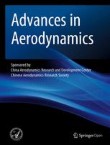Advances in Aerodynamics is affiliated with the with Computational Aerodynamics Institute, China Aerodynamics Research and Development Cernter and Chinese Aerodynamics Research Society.
Drag reducing nose fairings for existing freight train locomotives
At cruising speed, one of the most significant contributing factors to train fuel consumption is aerodynamic drag, and the leading locomotive experiences much more drag than any other car in the train. This wo...
